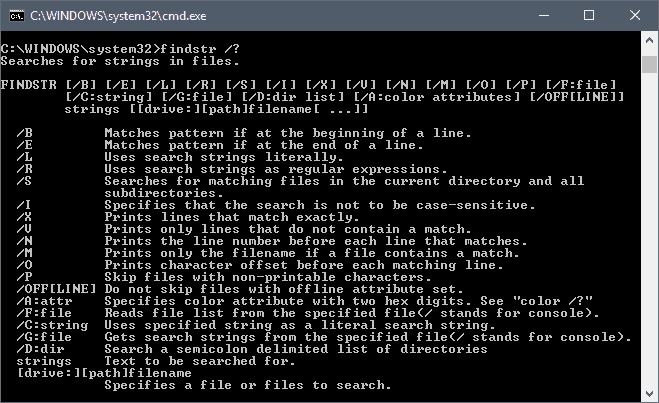
Pass this on the command line to have PowerGREP execute the entire sequence. Then select Sequence|Save in the menu to save everything into a.

If you need to schedule more than one action to be executed in sequence, add all those actions to the Sequence panel in PowerGREP. pga file that you then pass on the command line to PowerGREP. So anything you can do in PowerGREP’s interface, you can do from a program or script that you write, simply by having it write or modify a. pga files are XML files with a published schema. pga files, anything you can do in PowerGREP’s interface, you can do on its command line. It is tiny, but it still accepts about 5,000 characters.īecause all file selection and action options can be saved into. Don’t worry if the “add arguments” box seems tiny.
GREP COMMAND WINDOWS WINDOWS 8.1
The screen shot in the margin shows what this looks like with the Windows 8.1 task scheduler. Make sure to put double quotes around the path to the. pga file along with the /silent switch on the command line.
GREP COMMAND WINDOWS FULL
Then configure your task scheduler to run PowerGREP passing the full path to the. When ready, select Action|Save in the menu to save all the settings from the Action and File Selector panels into a. The easiest way to do this is to first prepare and test your action with PowerGREP’s graphical interface. While PowerGREP doesn’t have any built-in scheduling features, you can easily run it through any task scheduling software, including the Windows Task Scheduler that is included with Windows 2000 and later. If you have an automated process that regularly delivers new files, you can schedule PowerGREP to process those files at regular intervals. Silent execution is great for scheduled searches or file maintenance tasks. You could use /silent instead of /execute /quit to do the same silently, which means PowerGREP will run the search without showing anything on your monitor. To automate this from a batch file or a script, you could replace /preview with /execute /save “C:\output\results.html” /quit to save the search results into an HTML file for later inspection. For example, you could initiate a search with this command line: PowerGREP5.exe /search /regex /searchtext “foo|bar” /folder “C:\My Documents” /masks “*.txt” “*.bak” “” “” 0 /preview Screen shots of PowerGREP’s GUI also look much better than screen shots of the Windows command prompt.īut if you’re a command line junkie, you can access PowerGREP’s most frequently used features with direct command line parameters. That’s why this website and PowerGREP’s user’s guide focus on using PowerGREP through the point-and-click interface. Any feature is never more than a few clicks away. Most of the time you’ll work with PowerGREP’s GUI. All of its features can be used through both its rich graphical user interface (GUI) as well as via the command line. wants to 'install' ( parks trash for no reason), wants money (extra motive to park trash).

PowerGREP provides the best of both worlds. Modern Windows applications often only provide a point-and-click interface. Get-ChildItem -Path 'c:\tmp\' -Recurse -include "*.mp3","*.The original grep was a pure command line tool. To search files in the nested directories recursively, use the Get-ChildItem cmdlet: The previous example searches for a text in the specified directory only. Select-String -Path $path -Pattern "ERROR" -Include "*.txt","*.log" -Exclude "*copy*" The following command will search through all TXT and LOG files that do not contain copy in their names: Using the Exclude and Include options, you can include or exclude certain files for search. For example, this command can be useful for searching transport (SMTP) and message tracking logs on Exchange Server. You can use this command if you want to search through all files in a folder. Select-String -Path c:\tmp\*.txt -Pattern "ERROR" If you want to search for a string in all TXT files in a specific directory, run the command below:

The command has shown the number of lines that contain the text you are looking for and their values.


 0 kommentar(er)
0 kommentar(er)
